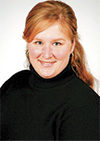Many horse owners find round bales convenient, less labor-intensive and more affordable than other hay types but report an inability to control horse weight gain and excessive hay waste.
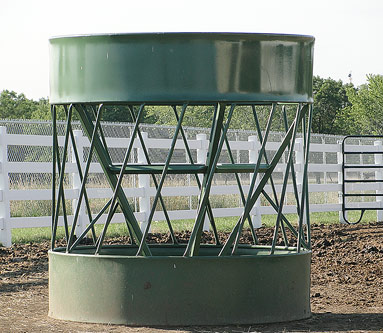
Several types of round-bale feeders exist, however, little research has been done to characterize hay waste resulting from different round-bale feeders when fed to horses.
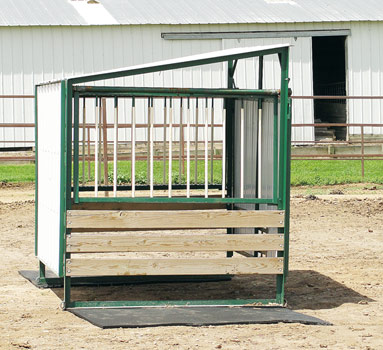
Researchers at the University of Minnesota set out to compare hay waste, hay intake and economics of nine round-bale feeders and a no-feeder control when used during horse feeding.
Nine round-bale feeders were tested: cinch net, cone, covered cradle, hayhut, hay sleigh, ring, tombstone, tombstone saver and waste less.
In June of 2010, 50 round bales were baled from a pure stand of orchardgrass. Round bales were stored until fed and, prior to storage, each round bale was individually weighed and analyzed.
Each feeder was placed on the ground in a dirt paddock. Each feeder was evaluated for 20 consecutive days by a total of 25 horses. Groups of five adult horses, quarter horse and thoroughbred geldings and open mares, were fed hay in each feeder over a four-day period.
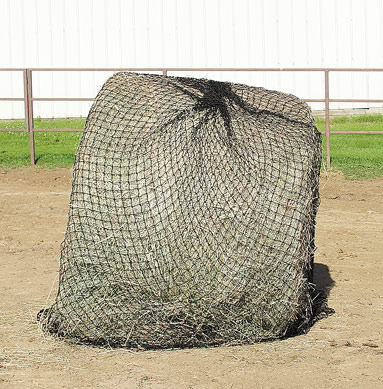
Every fourth day, groups of horses were rotated among paddocks, weighed and a new round bale was placed in each feeder.
Hay on the ground surrounding the feeder was collected daily, dried and weighed. The total amount of hay removed around each feeder for a four-day period was considered waste.
Dry matter intake was estimated as the difference between hay disappearance and waste. Number of months for the reduction in waste to repay feeder cost (payback) was calculated using hay valued at $100 per ton and improved feeder efficiency over the control.
The covered cradle had collapsible side-feeding panels that rested on the bale and compressed down as the bale was eaten. The waste less feeder also had collapsible side-feeding panels but panels were lowered by hand every day at 9 a.m. and 9 p.m. to ensure horses had constant access to hay in the feeder.
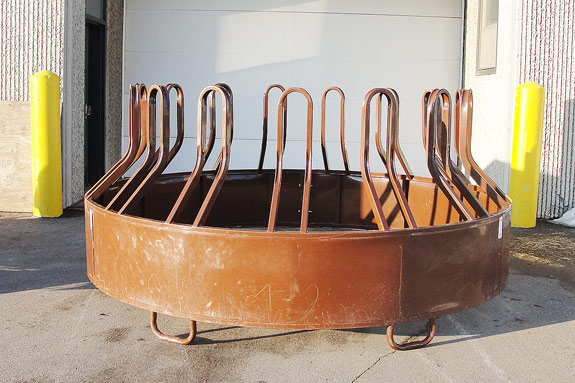
No injuries were observed from any feeder types during the data collection period. However, cosmetic rub marks along the sides of faces were observed on many horses feeding out of the waste less.
Experiments utilizing different age groups of horses, and for longer durations, would help to further examine the safety of each feeder. After two days of feeding off the cinch net, the round bale collapsed down and horses were able to stand and defecate on the remaining hay.
Thus, we recommend the cinch net be used in combination with another feeder to eliminate horse access as the round bale collapses during feeding. The manufacturer also recommends that horses should not be shod when feeding from the cinch net.
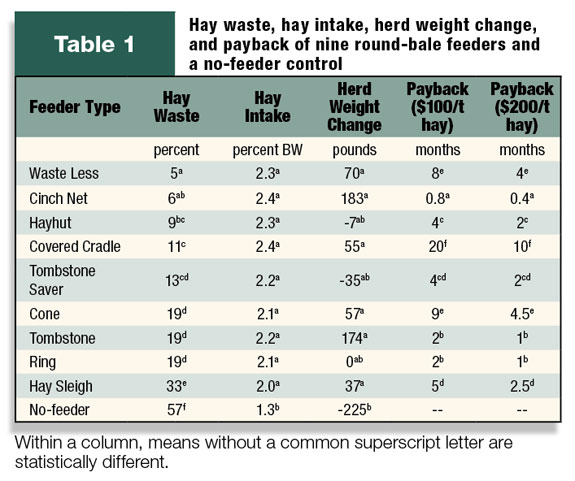
The orchardgrass hay met or exceeded the horses’ nutritional requirements for digestible energy (DE), crude protein (CP), calcium (Ca) and phosphorous (P) for non-working mature horses.
Feeder design did not affect hay intake; all feeders resulted in an estimated hay intake of 2.0 to 2.4 percent bodyweight (BW). However, the no-feeder control resulted in a reduced intake of 1.3 percent BW. Pen weight change was not different among feeder types.
However, when compared to the no-feeder control, six of the nine feeders resulted in small pen weight gains, including the cinch net, cone, covered cradle, hay sleigh, tombstone and waste less feeders.
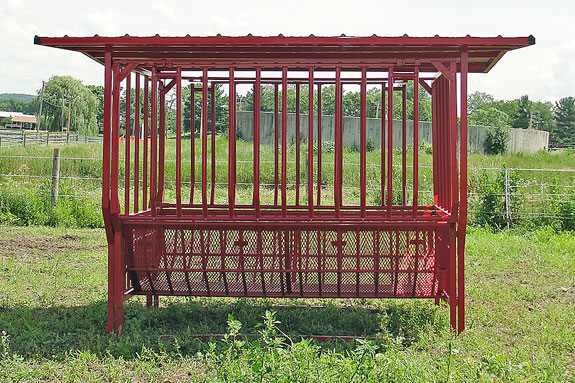
The no-feeder control resulted in greater pen weight loss than six of the feeders, but was not different from the hayhut, ring or tombstone saver. At 1.3 percent BW of estimated hay intake, DE requirements were not met with the no-feeder control, accounting for the pen weight loss, although CP, Ca and P requirements were still met.
Mean percent hay waste differed among feeders: waste less, 5 percent; cinch net, 6 percent; hayhut, 9 percent; covered cradle, 11 percent; tombstone saver, 13 percent; tombstone, cone and ring, 19 percent; hay sleigh, 33 percent; and no-feeder control, 57 percent.
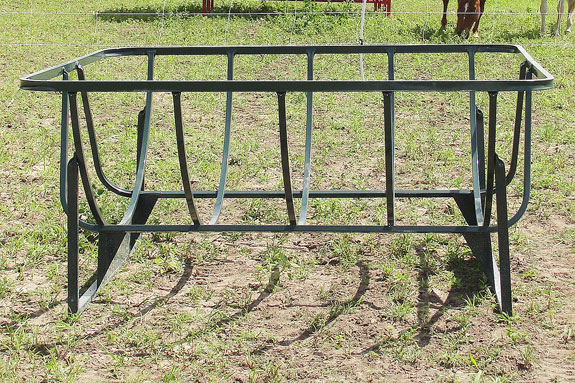
Feeder design also affected payback. The cinch net paid for itself in less than one month; tombstone and ring, two months; hayhut and tombstone saver, four months; hay sleigh, five months; waste less, eight months; cone, nine months; and covered cradle, 20 months.
As hay increases to $200 per ton, months to pay back the feeder costs are cut in half. Although the cinch net paid for itself in the shortest amount of time, the net material is guaranteed to last for three years, while all other feeders claim to last indefinitely. However, feeder longevity was not measured in this study nor accounted for in the payback.
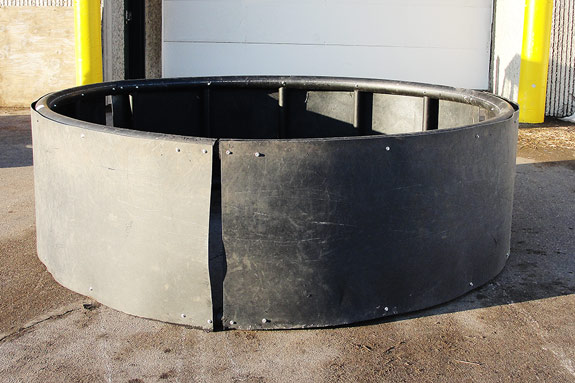
Round-bale feeder design affected hay waste and economics but not safety, hay intake or herd weight change during horse feeding.
The use of a round-bale feeder, regardless of design, is necessary to avoid 57 percent hay waste, reduced hay intake and horse weight loss observed when not utilizing a feeder.
The excessive hay waste observed with the no-feeder control will also likely contribute to insect breeding areas, mud and additional manure removal costs.
Economics were impacted by both waste efficiency and feeder purchase price; however, all feeders repaid their cost within 20 months with hay valued at $100 per ton. This information is useful when purchasing round-bale feeders and estimating hay needs.
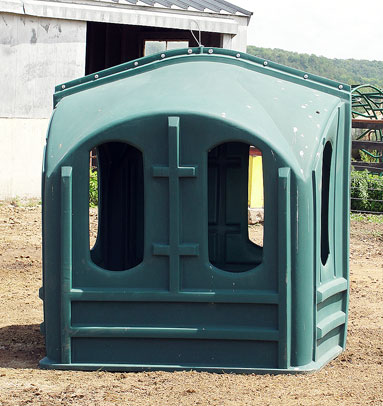
This project was funded by a grant from the Minnesota Horse Council, manufacturer fees and with cooperation from the University of Wisconsin – River Falls. Mention of trade names is solely to provide specific information and does not imply recommendation or endorsement by the University of Minnesota. Prices quoted at time of research; July 2010.
The research was recently published in the Journal of Animal Science.
This article was also co-authored by Julia Wilson, Kristen Cleary, Will Thomas, Bill Lazarus and Marcia Hathaway.
PHOTOS
Varieties of round bale feeders used in the study included (pictures top to bottom) the cone, waste less, cinch net, tombstone saver, the covered cradle, hay sleigh, solid poly ring and hayhut. Photos courtesy of the University of Minnesota.
Krishona Martinson
Equine Extension Specialist
University of Minnesota
